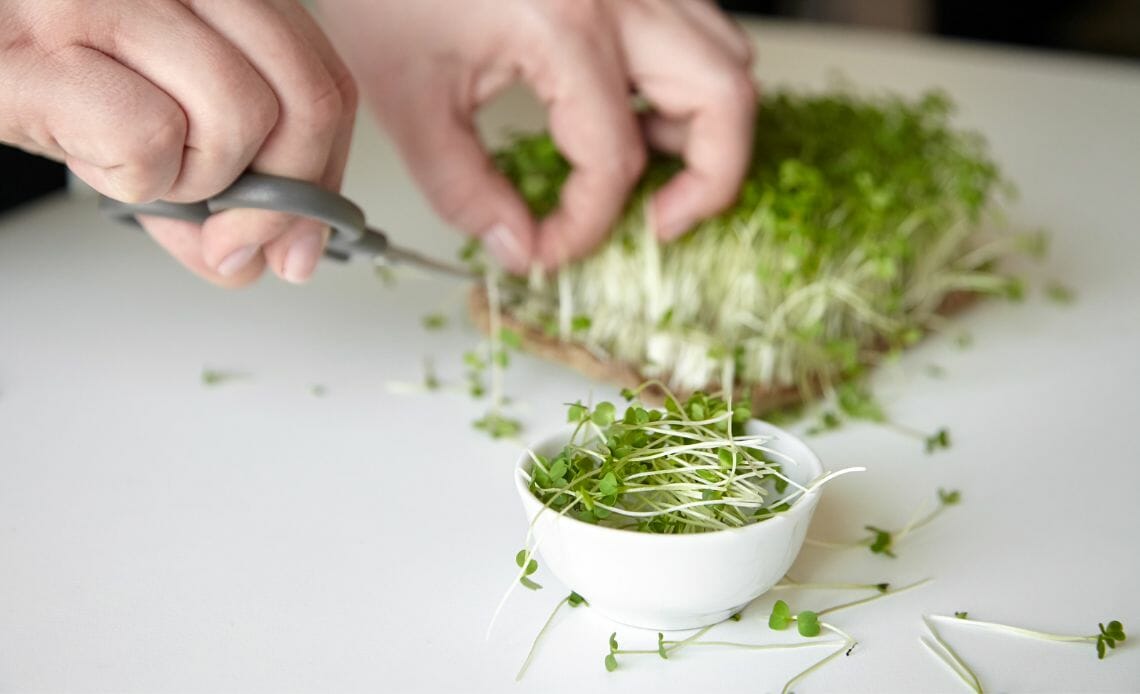
In the world of fresh greens, microgreens stand as a remarkable intermediary between sprouts and baby greens. These young vegetable greens are harvested just after they’ve sprouted and produced their first set of true leaves. Despite their small size, microgreens possess immense potential and offer many benefits.
Table of Contents
Nutrient Content
Microgreens are like miniature powerhouses, brimming with an extraordinary concentration of nutrients and vitamins. You’ll find a wealth of vitamins within their delicate leaves, including vitamins C, E, and K, lutein, and beta-carotene. Furthermore, microgreens boast an array of minerals, such as iron, zinc, and potassium. While the exact nutrient content varies depending on the plant variety, one thing remains consistent: microgreens are significantly more nutrient-dense compared to their mature counterparts. These tiny greens offer a captivating symphony of flavor and nutrition.
Flavor
Prepare to be mesmerized by the intense aromatic flavor that microgreens bring to the table. Despite their diminutive size, these vibrant greens pack a punch in terms of taste. With an extensive range of colors, textures, and flavors, microgreens offer a compelling experience for your taste buds. Microgreens can elevate any dish from being a delightful pizza topping to a zesty addition to tacos, sandwiches, salads, and even fillings for ravioli, pierogis, or empanadas.
Convenience
The beauty of microgreens lies not only in their flavor and nutrition but also in their unparalleled convenience. These greens are straightforward to grow, making them accessible to everyone. You can cultivate your microgreens with a spacious backyard, a cozy greenhouse, or a sunny windowsill. Moreover, you can buy whole microgreens and cut them as needed, keeping them alive until the moment of consumption. The convenience of microgreens extends beyond their growth; they bring joy and accessibility to every step of the process.
Health Benefits
Microgreens offer more than just delectable flavors; they also have various health benefits. Incorporating microgreens into your diet can significantly reduce the risk of chronic diseases such as heart disease and cancer. Their high concentration of antioxidants provides a shield against cellular damage caused by free radicals, safeguarding your overall well-being. Adding a handful of microgreens to your meals can nourish your body and promote long-term health.
Easy to Grow
Gardening enthusiasts and newcomers alike will find solace in the ease of growing microgreens. These greens are a dream come true for apartment dwellers and garden enthusiasts with limited space. Whether you grow them in soil or hydroponically, the process is straightforward and requires minimal space and equipment. With just a little effort and care, you can experience the joy of cultivating your microgreens right in the comfort of your home.
FAQs
Q: Can I grow microgreens indoors?
A: Absolutely! Microgreens can be grown indoors, making them accessible to anyone with limited space. A windowsill or a countertop with adequate light can be ideal for cultivating these nutritious greens.
Q: How long do microgreens take to grow?
A: The time it takes for microgreens to grow varies depending on the type of greens and environmental factors. On average, microgreens are ready to harvest within 1 to 3 weeks after sowing the seeds.
Q: Are microgreens safe to eat raw?
A: Yes, microgreens are safe to eat raw. Consuming them raw ensures maximum retention of their nutrients and flavors. However, washing them thoroughly before use is crucial to remove any dirt or contaminants.
Q: Can I use regular soil to grow microgreens?
A: While it’s possible to use regular soil for growing microgreens, it’s recommended to use a sterile soilless growing medium. These media provide better drainage and reduce the risk of soil-borne diseases.
Q: Where can I buy microgreen seeds?
A: Microgreen seeds are available online, at garden centers, and in some grocery stores. Look for organic and non-GMO seeds to ensure the best quality for your microgreen cultivation.
Conclusion
Microgreens not only benefit your health but also contribute to the sustainability of our planet. By growing microgreens indoors, you actively participate in reducing the need for long-distance transportation and excessive storage. Furthermore, microgreens require less water and fertilizer than their fully grown counterparts, making them an environmentally conscious choice. Embracing microgreens as a sustainable source of fresh produce empowers you to impact the world positively.
Also Read: LMNT: The Ultimate Electrolyte Drink Mix for Active Individuals

